
doi.org/10.15178/va.2019.149.67-89
RESEARCH
WEVIDEO: CLOUD SERVICE USEFUL FOR STUDENTS DURING THE CONSTRUCTION AND PRESENTATION OF AUDIOVISUAL CONTENTS?
WEVIDEO: ¿SERVICIO EN LA NUBE ÚTIL PARA LOS ESTUDIANTES DURANTE LA CONSTRUCCIÓN Y PRESENTACIÓN DE LOS CONTENIDOS AUDIOVISUALES?
WEVIDEO: SERVIÇO NA NUVEM ÚTIL PARA OS ESTUDNTES DURANTE A CONSTRUÇÃO E APRESENTAÇÃO DOS CONTEÚDOS AUDIOVISUAIS?
Ricardo-Adán Salas-Rueda1
José-Adán Salas-Silis2
1Institute of Applied Sciences and Technology (National Autonomous University of Mexico). Mexico.
2La salle university. Mexico.
ABSTRACT
This quantitative and qualitative research analyzes the impact of the WeVideo cloud service during the teaching-learning process. The students of the Computational Mathematics subject used this web application with the purpose of constructing and presenting diverse audiovisual contents related to the topics of Database, ERP System, CRM System and Data Mining. The sample consists of 20 students who were studying the Bachelor in Business Management and Information Technology during the 2017 school year. The results obtained indicate that WeVideo is an ideal tool for the educational process due to the fact that students have an active role in learning during the creation and presentation of audiovisual content. Data science identifies 4 predictive models on the use of WeVideo in the educational field by means of the decision tree technique. WeVideo encourages students’ creativity, allows the development of skills, favors collaboration between classmates and increases motivation. In conclusion, new technologies facilitate the planning and implementation of innovative and creative scenarios for learning and teaching.
KEY WORDS: ICT, technology, cloud service, higher education, learning, educational technology, WeVideo, data science
RESUMEN
Esta investigación cuantitativa y cualitativa analiza el impacto del servicio en la nube WeVideo durante el proceso de enseñanza-aprendizaje. Los estudiantes de la asignatura Matemáticas Computacionales utilizaron esta aplicación web con el propósito de construir y presentar diversos contenidos audiovisuales relacionados con los temas de Base de datos, Sistema ERP, Sistema CRM y Minería de datos. La muestra está conformada por 20 alumnos que cursaron la Licenciatura en Gestión de Negocios y Tecnologías de Información durante el ciclo escolar 2017. Los resultados obtenidos indican que WeVideo es una herramienta idónea para el proceso educativo debido a que los universitarios presentan un rol activo en el aprendizaje durante la creación y presentación de los contenidos audiovisuales. La ciencia de datos identifica 4 modelos predictivos sobre el uso de WeVideo en el campo educativo por medio de la técnica árbol de decisión. WeVideo fomenta la creatividad de los estudiantes, permite el desarrollo de las habilidades, favorece la colaboración entre los compañeros e incrementa la motivación. En conclusión, las nuevas tecnologías facilitan la planeación e implementación de escenarios innovadores y creativos para el aprendizaje y la enseñanza.
PALABRAS CLAVE: TIC, tecnología, servicio en la nube, enseñanza superior, aprendizaje, tecnología educativa, WeVideo, ciencia de datos
RESUME
Esta investigação quantitativa e qualitativa analisa o impacto do serviço na nuvem WeVideo durante o processo de ensino aprendizagem. Os estudantes de Matemáticas Computacionais utilizaram esta aplicação web com o propósito de construir e apresentar diversos conteúdos audiovisuais relacionados com temas de Base de Dados, Sistema ERP, Sistema CRM e Extraçao de Dados. A amostra esta composta por 20 alunos que cursaram a Licenciatura em Gestão de Negócios e Tecnologias de informação durante o ciclo escolar 2017. Os resultados obtidos indicam que Wevideo é uma ferramenta idônea para o processo educativo devido a que os universitários apresentam um papel ativo na aprendizagem durante a criação e apresentação dos conteúdos audiovisuais. A ciência de dados identifica 4 modelos preditivos sobre o uso de Wevideo no campo educativo por meio da técnica arvore de decisão Wevideo fomenta a criatividade dos estudantes, permite o desenvolvimento das habilidades, favorece a colaboração entre os companheiros e incrementa a motivação. Em conclusão, as novas tecnologias facilitam a planificação e implementação de cenários inovadores e criativos para a aprendizagem e o ensino.
PALAVRAS CHAVE: tecnologia, serviço na nuvem, ensino superior, Aprendizagem tecnologia educativa, Wevideo, ciência de dados
How to cite the article: Salas-Rueda, R. A. & Salas-Silis, J. A. (2019). WeVideo: cloud service useful for students during the construction and presentation of audiovisual content? [WeVideo: ¿Servicio en la nube útil para los estudiantes durante la construcción y presentación de los contenidos audiovisuales?]. Vivat Academia. Revista de Comunicación, (149), 67-89.
doi: http://doi.org/10.15178/va.2019.149.67-89
Recovered from http://www.vivatacademia.net/index.php/vivat/article/view/1115
Correspondence: Ricardo-Adán Salas-Rueda: Institute of Applied Sciences and Technology (National Autonomous University of Mexico). Mexico.
ricardoadansalasrueda@hotmail.com
José-Adán Salas-Silis La salle university. Mexico.
adansalasinvestigacion@gmail.com
Received: 28/01/2018
Accepted: 21/05/2019
Published: 15/12/2019
1. INTRODUCTION
Today, educational institutions are incorporating Information and Communication Technologies (ICT) in school activities with the purpose of improving the teaching- learning process (Imms and Byers, 2017; Magen and Steinbe rger, 2017; Sahlin, Tsertsidis and Islam, 2017). In particular, digital tools facilitate interactive communication, problem solving and simulation of real situations (Barrientos, 2016; Salas, Salas, Salas and Várgas, 2019).
Young people use ICT in most of their daily activities, therefore, teachers are changing the planning and organization of educational activities developed inside and outside the classroom through digital tools (Botella, Ramos and Hurtado, 2016; Shaqrah, 2015).
Technological advances are becoming a key element to achieve educational innovation (Aparicio, Bacao and Oliveira, 2016; Bowers and Kumar, 2015). In fact, universities are more frequently using online tools and web applications to develop skills in students (Brown, 2016; Salas, 2015).
The benefits of technology in the educational field are related to the ease of access to information, interactivity between users and individualized learning (Barrientos, 2016). It is worth mentioning that collaborative learning through ICT develops social skills and encourages group work among students to know, share and expand information (Casas, 2016).
It is valuable to mention that ICT have a fundamental role in the educational context because these technological applications are used as a supporting instrument to develop school activities efficiently (Boada, 2016; Cohn and Fraser, 2016; Rohatgi, Scherer and Hatlevik, 2016).
The cloud service represents an ideal technological alternative to meet the needs of students in the 21st century (Lim, Gronlund and Andersson, 2015; Salas, 2018). In particular, this technological tool facilitates the creation of various digital products and multimedia resources (Fuentes, Moreno, Lara and Jiménez, 2017; Huang, 2016; Salas and Vázquez, 2017).
Therefore, this mixed research analyzes the impact of the WeVideo cloud service in the educational field. The students of the subject Computational Mathematics used this web application with the purpose of building and presenting various audiovisual contents related to the topics of Database, ERP System, CRM System and Data Mining
The research questions are:
2. OBJECTIVES
The objectives of this mixed study (quantitative and qualitative) are to:
3. METHODOLOGY
3.1. Objective
The general objective of this research is to analyze the impact of the WeVideo cloud service during the teaching-learning process. The students of the subject Computational Mathematics used this web application with the purpose of constructing and presenting diverse audiovisual contents related to the topics of Database, ERP System, CRM System and Data Mining.
3.2. Participants
This quantitative and qualitative research was carried out in the subject Computational Mathematics during the 2017 school year. The sample is made up of 20 students (5 students and 15 students with an average age of 19.8 years) who completed the third semester of the degree in Management Business and Information Technology in a Mexican university.
3.3. Procedure
The procedure of this mixed study began with the design of teaching-learning activities on the development and presentation of audiovisual contents through the WeVideo cloud service (see table 1).
Table 1. Teaching-learning activities through WeVideo.

Source: Own elaboration, 2018.
It is worth mentioning that the students of the degree in Business Management and Information Technology opened an email account at Gmail to access WeVideo through Google drive. Likewise, the students formed teams of 5 members to build and present the audiovisual contents through this cloud service.
During 4 face-to-face sessions of the subject Computational Mathematics, the students of the Bachelor’s degree in Business Management and Information Technology presented the topics on the Database, the ERP System, the CRM System and Data Mining through the audiovisual contents developed in WeVideo.
The hypotheses of this mixed research are:
On the other hand, the predictive models on the use of the WeVideo cloud service in the educational field are:
3.4. Data analysis
The spreadsheet is used to calculate the frequency, the percentage frequency and the correlation coefficient. Likewise, the tool Rapidminer allows the construction of predictive models on the use of the WeVideo cloud service in the teaching-learning process (data science).
Finally, the analysis of the qualitative data is carried out considering the perceptions of the students who studied Computational Mathematics during the 2017 school year.
3.5. Data collection
The measuring instrument (questionnaire) consists of 23 questions related to the characteristics of the students, the assimilation of knowledge, the usefulness of the WeVideo cloud service, the WeVideo web interface and the students’ perceptions:
Finally, the measuring instrument was applied during the month of November 2017 in the subject Computational Mathematics.
4. RESULTS AND DISCUSSION
4.1. Impact of the WeVideo cloud service
According to the students of the subject Computational Mathematics (n=10.50%), the WeVideo application totally facilitates the assimilation of knowledge on the topics of Database and CRM System (see table 2). Even this cloud service totally facilitates the assimilation of knowledge about the ERP System (n=7.35%) and Data Mining (n=8.40%).
Table 2. Assimilation of knowledge through WeVideo.
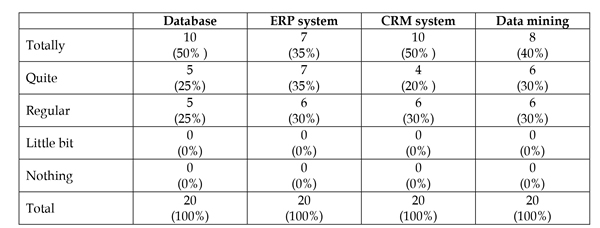
Source: Own elaboration, 2018.
Graph 1 shows that the majority of university students (43.75%) are located in the category Totally for the variable assimilation of knowledge through the application WeVideo.
Source: Own elaboration, 2018.
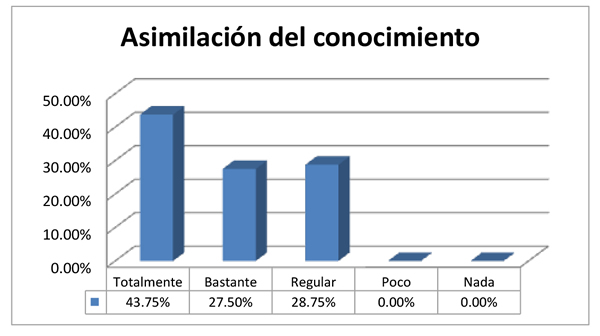
Graph 1: Assimilation of knowledge.
Table 3 shows that WeVideo totally facilitates the construction of audiovisual content through the use of the image (n=12.60%), Voice (n=10.50%), Music (n=12.60%) and Text (n=12.60%).
Table 3. Utility of WeVideo to build audiovisual content.

Source: Own elaboration, 2018.
Graph 2 shows the results on the utility of the WeVideo cloud service.
Source: Own elaboration, 2018.
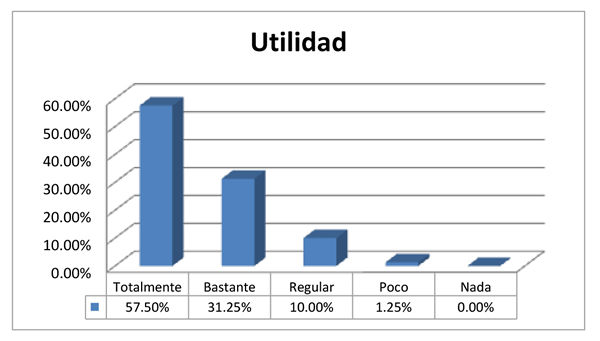
Graph 2: WeVideo Utility.
Students of the Bachelor’s degree in Business Management and Information Technology (n=10.50%) point out that the web interface is quite simple and easy to build audiovisual content. Even table 4 indicates that 45% of the participants (n=9) are in the category totally for the Fast and Fun dimensions of the WeVideo interface.
Table 4. WeVideo interface.
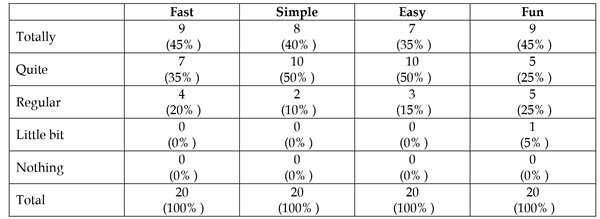
Source: Own elaboration, 2018.
Graph 3 shows that the majority of respondents (41.25%) are placed in the category Totally for the variable Web Interface (WeVideo). Also, 40.00% of university students are in the category Quite a lot.
Source: Own elaboration, 2018.
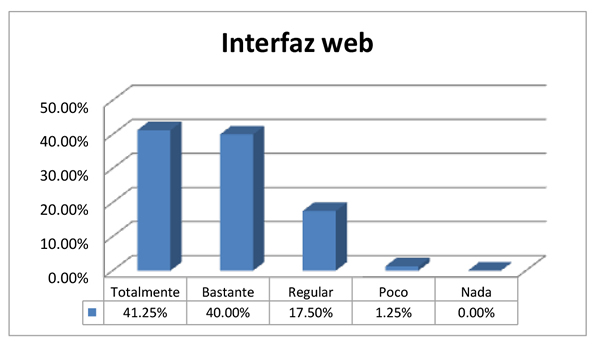
Graph 3: Web interface.
Figure 1 shows that the fast WeVideo web interface has a positive relationship with the assimilation of knowledge for showing a value higher than 0.50, that is, the correlation coefficients are Database (0.6883951), ERP System (0.62827226), CRM System (0.673444456) and Data Mining (0.510451965). Therefore, hypothesis 1 is accepted.
Source: Own elaboration, 2018.
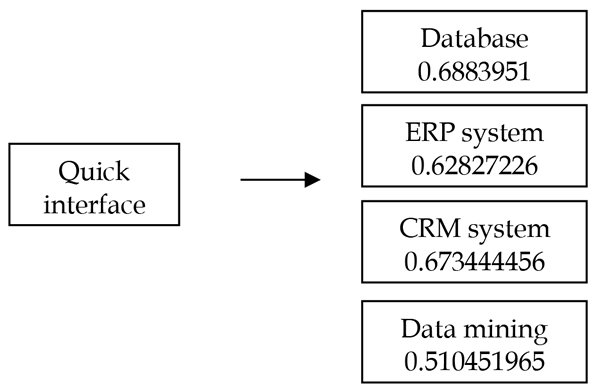
Figure 1: Relationship between the rapid interface and knowledge assimilation.
On the other hand, the simple WeVideo web interface has a significant positive relationship with the assimilation of knowledge on the topics of the Database (0.423793448) and Data Mining (0.413624454). Figure 2 shows that all correlation coefficients are greater than the value of 0.34. Therefore, hypothesis 2 is accepted.
Source: Own elaboration, 2018.
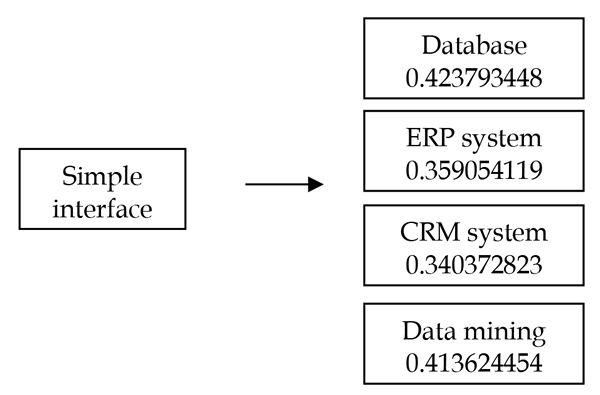
Figure 2: Relationship between the simple interface and knowledge assimilation.
Figure 3 shows that there is no significant positive relationship between the easy WeVideo web interface and the assimilation of knowledge because the values of the correlation coefficient are less than 0.35:
Database: 0.266732535
ERP system: 0.3481407
CRM System: 0.186040275
Data mining: 0.230749034
However, hypothesis 3 is accepted.
Source: Own elaboration, 2018.
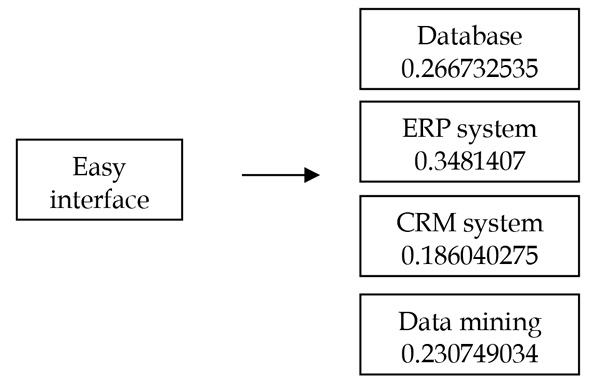
Figure 3: Relationship between the easy interface and knowledge assimilation.
Finally, Figure 4 shows that the fun WeVideo web interface has a significant positive relationship with the assimilation of knowledge on the topics of Database (0.415481802) and CRM System (0.462042364). Hypothesis 4 is accepted.
Source: Own elaboration, 2018.
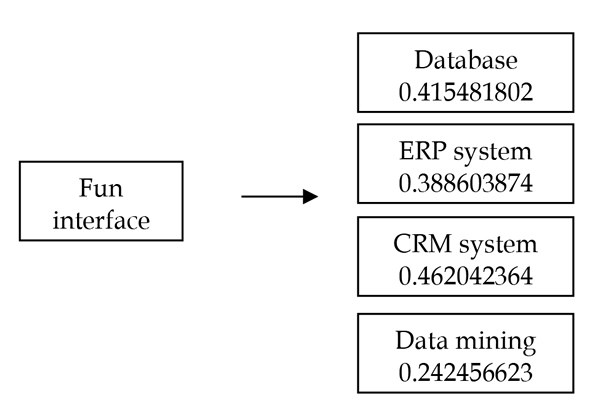
Figure 4: Relationship between the fun interface and knowledge assimilation.
4.2. Student perceptions
According to the students of the subject Computational Mathematics, the WeVideo cloud service is an innovative tool for the teaching-learning process:
Also, university students point out that WeVideo is an easy and simple tool to create audiovisual content:
It is worth mentioning that the WeVideo cloud service encourages student creativity:
The participants think that WeVideo facilitates the educational process through the construction of audiovisual content:
In addition, students of the Bachelor’s degree in Business Management and Information Technology mention that this service in the cloud allows the development of skills:
In the same way, the students of the subject Computational Mathematics indicate that WeVideo favors the collaboration among the partners:
One of the benefits of WeVideo is related to the ease of creating audiovisual content:
In fact, this cloud service facilitates the teaching-learning process in the subject Computational Mathematics:
Respondents indicate that they are satisfied to use the WeVideo cloud service during the educational process:
Similarly, WeVideo motivates university students during the teaching-learning process:
The WeVideo cloud service facilitates the construction of innovative and creative educational experiences:
4.3. Data science
Figure 5 shows the predictive model 1 on the WeVideo web interface and knowledge assimilation (Database). For example, if the student thinks the web interface of WeVideo fully facilitates the construction of audiovisual content and it is a man then this service in the cloud facilitates fully assimilating knowledge of the database.
Source: Own elaboration, 2018.
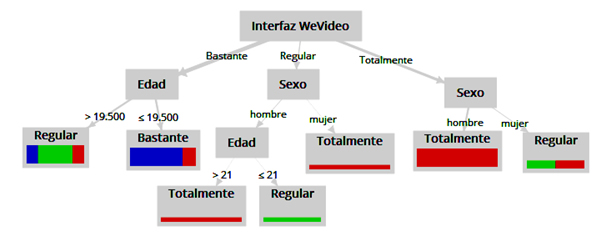
Figure 5: Predictive model 1 on WeVideo.
On the other hand, if the student thinks the web interface of WeVideo greatly facilitates the construction of audiovisual content and has an age ≤19.5 years then this service in the cloud rather facilitates the assimilation of knowledge about the database. The accuracy of predictive model 1 is 80.00% (see Figure 6).
Source: Own elaboration, 2018.

Figure 6: Accuracy of predictive model 1 on WeVideo.
Figure 7 shows the predictive model 2 on the WeVideo web interface and knowledge assimilation (ERP System). For example, if the student thinks the web interface of WeVideo fully facilitates the construction of audiovisual content, it is male and has an age> 19.5 years then this service in the cloud fully facilitates assimilating knowledge of the ERP system.
Source: Own elaboration, 2018.
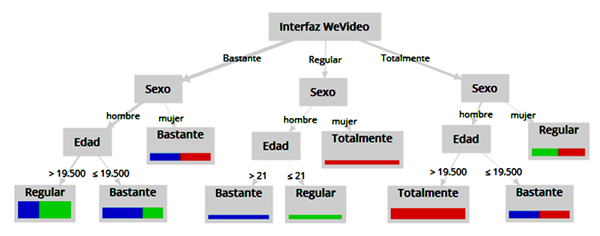
Figure 7: Predictive model 2 on WeVideo.
On the other hand, if the student thinks the web interface of WeVideo greatly facilitates the construction of audiovisual content and it is a woman then this cloud service greatly facilitates the assimilation of knowledge about the ERP system. The accuracy of predictive model 2 is 70.00% (see Figure 8).
Source: Own elaboration, 2018.

Figura 8: Accuracy of predictive model 2 on WeVideo.
Figure 9 shows the predictive model 3 on the WeVideo web interface and the assimilation of knowledge (CRM System). For example, if the student thinks the web interface of WeVideo fully facilitates the construction of audiovisual content, it is male and has an age ≤19.5 years then this service in the cloud facilitates rather the assimilation of knowledge about the CRM system.
Source: Own elaboration, 2018.
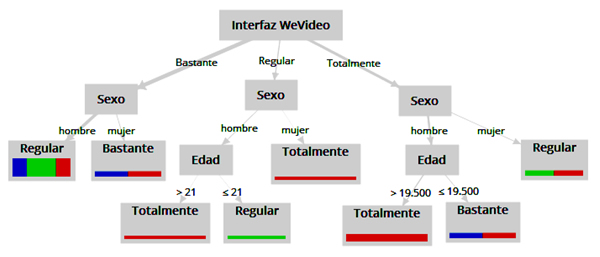
Figure 9: Predictive model 3 on WeVideo.
On the other hand, if the student thinks the interface web of WeVideo facilitates rather the construction of audiovisual content and it is a woman then this service in the cloud rather facilitates the assimilation of knowledge about the CRM system. The accuracy of predictive model 3 is 65.00% (see Figure 10).
Source: Own elaboration, 2018.

Figure 10: Accuracy of predictive model 3 on WeVideo.
Figure 11 shows the predictive model 4 on the WeVideo web interface and the assimilation of knowledge (Data mining). For example, if the student thinks the web interface of WeVideo fully facilitates the construction of audiovisual content, is male and has an age ≤19.5 years then this service in the cloud facilitates rather the assimilation of knowledge about mining data.
Source: Own elaboration, 2018.
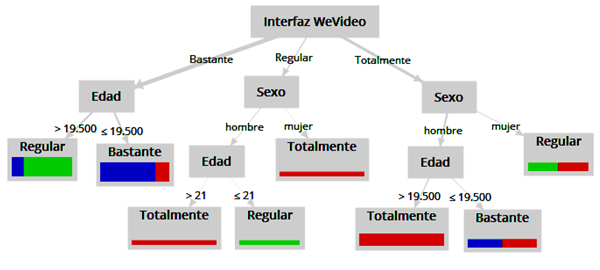
Figure 11: Predictive model 4 on WeVideo.
On the other hand, if the student thinks the web interface of WeVideo greatly facilitates the construction of audiovisual content and has an age ≤19.5 years then this service in the cloud rather facilitates the assimilation of knowledge about data mining. The accuracy of predictive model 4 is 80.00% (see Figure 12).
Source: Own elaboration, 2018.

Figure 12: Accuracy of predictive model 4 on WeVideo.
4.4. Discussion
The cloud service allows users to access applications through the web browser (Fuentes, Moreno, Lara and Jiménez, 2017). In particular, students of the Bachelor’s degree in Business Management and Information Technology use the WeVideo tool through Google drive in order to create various audiovisual contents.
This study confirms the ideas of Boada (2016) about the importance of ICT to develop school work and promote the search for resources. In particular, the students of the subject Computational Mathematics investigated the information on the topics of Database, ERP System, CRM System and Data Mining with the purpose of constructing diverse audiovisual contents through the WeVideo cloud service.
It is valuable to mention that the WeVideo web interface is fast, simple, easy and fun for the teaching-learning process. Even, university students indicate that this application facilitates the assimilation of knowledge, collaboration between colleagues and teamwork.
Service in the cloud motivates learning in students (Fuentes Moreno, Lara and Jiménez, 2017). For example, WeVideo represents an ideal medium for the educational context because this cloud service encourages creativity and skill development.
This mixed study confirms the ideas of various authors (eg, Aparicio, Bacao and Oliveira, 2016; Mellati, Azad and Khademi, 2015; Salas, Vázquez and Lugo, 2016 ) on the positive impact of technology on the educational process . In fact, university students point out that they are satisfied to use the WeVideo cloud service during the construction and presentation of audiovisual content through the use of images, voice, music and text.
On the other hand, this research identifies the existence of a positive relationship between the assimilation of knowledge and the WeVideo web interface (fast, simple, easy and fun) by means of the correlation coefficient.
Data science establishes 4 predictive models of the WeVideo cloud service during the educational process with an accuracy greater than 64.99%. In the predictive model 1 if the student thinks the web interface of WeVideo fully facilitates the construction of audiovisual content and it is a man then this service in the cloud facilitates fully assimilating knowledge of the database.
In the predictive model 2 if the student thinks the web interface of WeVideo greatly facilitates the construction of audiovisual content and it is a woman then this service in the cloud rather facilitates the assimilation of knowledge about the ERP system.
In the predictive model 3, if the student thinks web interface of WeVideo fully facilitates the construction of audiovisual content, it is a man and has an age ≤19.5 years then this service in the cloud facilitates rather the assimilation of knowledge about the CRM system.
In the predictive model 4, if the student thinks the web interface of WeVideo greatly facilitates the construction of audiovisual content and has an age ≤19.5 years then this service in the cloud facilitates rather the assimilation of knowledge about data mining.
Finally, the use of ICT in the classroom improves the teaching-learning process (Chipangura and Aldridge, 2017; Sahlin, Tsertsidis & Islam, 2017; Salas, 2016).
5. CONCLUSIONS
The Wevideo cloud service is an ideal technological tool to foster an active attitude in the student, improve skills and improve teaching-learning conditions. In fact, university students consider that this application facilitates the assimilation of knowledge about the Database, the ERP System, the CRM System and Data Mining through the construction and presentation of audiovisual content.
In particular, the students of the Bachelor’s degree in Business Management and Information Technology are satisfied and motivated to use the application WeVideo in the subject Computational Mathematics. In addition, this cloud service has a fast, simple, easy and fun web interface that enables to create audiovisual content through the use of images, voice, music and text.
It is recommended that teachers identify and use the new Information and Communication Technologies such as the application WeVideo in order to implement creative and innovative educational experiences.
The limitations of this study are related to the use of the WeVideo cloud service in the educational process of computing. Therefore, future research may analyze the impact of WeVideo on the fields of administration, medicine and humanities.
The implications of this study promote the incorporation of technological tools in school activities in order to build new spaces for learning and teaching.
In conclusion, the WeVideo cloud service is a technological tool that encourages collaboration, teamwork and autonomous student learning.
REFERENCES
1. Aparicio, M., Bacao, F. & Oliveira, T. (2016). Cultural impacts on e-learning systems’ success. Internet and Higher Education, (31), 58-70. doi: https://doi.org/10.1016/j.iheduc.2016.06.003
2. Barrientos Báez, A. (2016). GDS Amadeus: propuesta de innovación didáctica, en Durán Medina, J. F. y Durán Valero, I. (Eds.), TIC actualizadas para una nueva docencia universitaria (pp. 17-30), Madrid: McGraw-Hill Interamericana.
3. Boada, A. (2016). Potencialidades de la herramienta Sakai en la enseñanza universitaria, en Durán Medina, J. F. y Durán Valero, I. (Eds.), TIC actualizadas para una nueva docencia universitaria (pp. 57-66), Madrid: McGraw-Hill Interamericana.
4. Botella Nicolás, A. M., Ramos Ahijado, S. y Hurtado Soler, A. (2016). Hacia una renovación de metodologías docentes en la educación superior, en Durán Medina, J. F. y Durán Valero, I. (Eds.), TIC actualizadas para una nueva docencia universitaria (pp. 81-88), Madrid: McGraw-Hill Interamericana.
5. Bowers, J. & Kumar, P. (2015). Students’ Perceptions of Teaching and Social Presence: A Comparative Analysis of Face-to-Face and Online Learning Environments. International Journal of Web-Based Learning and Teaching Technologies, 10(1), 27-44.
6. Brown, M. (2016). Blended instructional practice: A review of the empirical literature on instructors’ adoption and use of online tools in face-to-face teaching. Internet and Higher Education, 31, 1-10. doi: https://doi.org/10.1016/j.iheduc.2016.05.001
7. Casas Agudo, D. (2016). Aprendizaje colaborativo a través de wiki y de blog, en Durán Medina, J. F. & Durán Valero, I. (Eds.), TIC actualizadas para una nueva docencia universitaria (pp. 101-116), Madrid: McGraw-Hill Interamericana.
8. Chipangura, A. & Aldridge, J. (2017). Impact of multimedia on students’ perceptions of the learning environment in mathematics classrooms. Learning Environments Research, 20(1), 121-138. doi: https://doi.org/10.1007/s10984-016-9224-7
9. Cohn, S. T. & Fraser, B. J. (2016). Effectiveness of student response systems in terms of learning environment, attitudes and achievement. Learning Environments Research, 19(2), 153-167. doi: https://doi.org/10.1007/s10984-015-9195-0
10. Fuentes Martínez, A., Moreno Olivos, T., Lara Villanueva, R. S. y Jiménez Salazar, H. (2017). Experiencias con tecnologías colaborativas de Cloud Computing para la universidad, en Jaimez González, C. R., Miranda Campos, K. S., Vázquez Contreras, E. y Vázquez Vela, F. (Eds.), Estrategias didácticas en educación superior basadas en el aprendizaje: innovación educativa y tic (pp. 25-46). Ciudad de México: UAM Cuajimalpa.
11. Huang, Y. M. (2016). The factors that predispose students to continuously use cloud services: Social and technological perspectives. Computers & Education, 97, 86-96. doi: https://doi.org/10.1016/j.compedu.2016.02.016
12. Imms, W. y Byers, T. (2017). Impact of classroom design on teacher pedagogy and student engagement and performance in mathematics. Learning Environments Research, 20(1), 139-152. https://doi.org/10.1007/s10984-016-9210-0
13. Lim, N., Gronlund, A. & Andersson, A. (2015). Cloud computing: The beliefs and perceptions of Swedish school principals. Computers & Education, 84, 90-100. doi: https://doi.org/10.1016/j.compedu.2015.01.009
14. Magen Nagar, N. & Steinberger, P. (2017). Characteristics of an innovative learning environment according to students’ perceptions: actual versus preferred. Learning Environments Research, 20(3), 307-323. doi: https://doi.org/10.1007/s10984-017-9232-2
15. Mellati, M., Azad, I. & Khademi, M. (2015). The Impacts of Distance Interactivity on Learners’ Achievements in Online Mobile Language Learning: Social Software and Participatory Learning. International Journal of Web-Based Learning and Teaching Technologies, 10(3), 19-35.
16. Rohatgi, A., Scherer, R. & Hatlevik, O. (2016). The role of ICT self-efficacy for students’ ICT use and their achievement in a computer and information. Computers & Education, 102, 103-116. doi: https://doi.org/10.1016/j.compedu.2016.08.001
17. Sahlin, J., Tsertsidis, A. & Islam, M. (2017). Usages and impacts of the integration of information and communication technologies (ICTs) in elementary classrooms: case study of Swedish municipality schools. Interactive Learning Environments, 25(5), 561-579. doi: https://doi.org/10.1080/10494820.2016.1170045
18. Salas Rueda, R. A. (2018). Uso del servicio en la nube GeoGebra durante el proceso enseñanza-aprendizaje sobre las matemáticas. Revista iberoamericana para la investigación y el desarrollo educativo, (8), 23-52.
19. Salas Rueda, R. A. (2016). Diseño y análisis de un sistema web educativo considerando los estilos de aprendizaje. España: 3Ciencias.
20. Salas Rueda, R. A. (2015). Interfaz web usable: herramienta tecnológica para el proceso de enseñanza-aprendizaje. Revista de Comunicación de la SEECI, (36), 148-177. doi: http://dx.doi.org/10.15198/seeci.2015.36.148-177
21. Salas Rueda, R. A., Salas Rueda, E. P., Salas Rueda, R. D. y Várgas Pérez, Y. M. (2019). Análisis de la Aplicación Web Para la Estimación Puntual por medio de la Ciencia de Datos. Revista Dilemas Contemporáneos: Educación, Política y Valores, 6(2), 1-25.
22. Salas Rueda, R. A. y Vázquez Estupiñán, J. J. (2017). Innovación en el proceso educativo superior a través del servicio en la nube Erpag. Revista electrónica calidad en la educación superior, 8(2), 62-86. http://dx.doi.org/10.22458/caes.v8i2.1917
23. Salas Rueda, R. A., Vázquez Estupiñán, J. J. y Lugo García, J. L. (2016). Uso del avatar en el proceso de enseñanza aprendizaje sobre las aplicaciones de las derivadas. Revista de Comunicación de la SEECI, 39, 71-84. http://dx.doi.org/10.15198/seeci.2016.39.72-88
24. Shaqrah, A. (2015). Explain the Behavior Intention to Use e-Learning Technologies: A Unified Theory of Acceptance and Use of Technology Perspective. International Journal of Web-Based Learning and Teaching Technologies, 10(4), 19-32.
AUTHORS
Ricardo Adán Salas Rueda: Doctor in Design of New Technologies, Master in Administration and Engineer in Electronic Systems. Institute of Applied Sciences and Technology (National Autonomous University of Mexico). National researcher SNI level 1 (Conacyt) during the period 2019-2021 and Candidate SNI during the period 2016-2018. For 17 years he has taught computer science, mathematics and education at various universities.
ricardoadansalasrueda@hotmail.com
Orcid ID: http://orcid.org/0000-0002-4188-4610
Google Scholar: https://scholar.google.com.mx/citations?user=avsvdDUAAAAJ&hl=es&oi=ao
José Adán Salas Silis: Bachelor in accounting. Member of the group “Usable educational systems”. adansalasinvestigacion@gmail.com
Orcid ID: https://orcid.org/0000-0001-8539-3293